
I am currently a happy resident of the great state of Texas. It took me a while to reach the “happy” point, since I will always consider Oklahoma my home, but I’m becoming more comfortable with life in the Lone Star State as time goes by. I’m sure I could attribute part of that feeling to my job, which stinks at times, but it pays me more money than I ever realistically thought I would earn. Another part of it probably has to do with the fact that there are a lot of fun things to do in Dallas (which gives me plenty of opportunity to blow all of that hard-earned cash). But I would have to say that one of the foremost factors behind the reason why I love Texas is that I’ve found a Vs. community here that I’m happy to be a part of.
When I first came down to Dallas in the summer of 2004 for an internship with my current employer, I was a bit concerned that I might not be able to find a card shop that supported the Vs. System. After all, the Vs. System was still relatively new, so there weren’t many places that held tournaments or had an active community of players. And considering that this was right about the time that I started to really get into the game, I was genuinely worried that I might spend the summer quite Vs.-deprived.
Then, I ran across JJK Cards in Richardson. While the core group of players at JJK was not as competitively strong as the group I had played with in Oklahoma, they made up for this through an intense love and interest in the game. Also, they were not afraid to experiment. Prior to coming to Dallas, I had only played one-on-one games in the Vs. System, but my stay in Dallas quickly changed that, as the players there were quite fond of alternative formats—especially multi-player cutthroat!
Every Man for Himself!
The Vs. System rulebook provided with every starter deck gives the basic synopsis of how multiplayer games work. However, I will give those of you who have never played a cutthroat game a quick rundown of how it plays. The determination of initiative is the same as in one-on-one. However, in cutthroat, the initiative moves clockwise around the table rather than back and forth from player to player. Each player has the same phases to complete his or her actions. When effects are triggered, there is a determination of whether or not there is a target (i.e., target character, target opponent, etc.). For effects with a target, the controller of the effect must choose the target for that effect. For all other effects, the entire group of players will be affected. For example, a player activating Puppet Master will have to choose which opponent he wants to target with Puppet Master’s effect. On the other hand, if that same player uses the exhaustion effect of Two Face, Split Personality, it will affect all characters on the board with an odd or even cost, depending on what was called. Each player starts with 50 endurance, and all of the same rules apply for determining a winner.
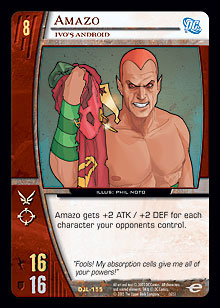 Cutthroat is a much different animal in Vs. System play from one-on-one. One major factor in competitive deckbuilding success is the ability to anticipate how your deck will fare against anything a single opponent will be able to throw at you. Cutthroat changes this completely, as you have to consider the actions of multiple opponents. While this seems like a very basic change, it alters the dynamics of the game dramatically! Cards that are normally looked down upon, such as Trok and Amazo, become unbelievable behemoths when you have several opponents to draw attack power from. On the other hand, Vs. System standards like Dr. Doom, Diabolic Genius and Sinestro, Green Lantern of Korugar become liabilities, as every other player in the game suddenly wants to take your character out of play. Attack pumps generally become less useful, as you will usually only have 1 or 2 turns with the initiative in any given game. And standard deck themes in one-on-one play, like rush, control, and stall, become almost unplayable, as your deck’s strategy isn’t viable against several opponents. But probably the most important thing to remember in cutthroat is that no deck will be able to win with any consistency.
Cutthroat is a much different animal in Vs. System play from one-on-one. One major factor in competitive deckbuilding success is the ability to anticipate how your deck will fare against anything a single opponent will be able to throw at you. Cutthroat changes this completely, as you have to consider the actions of multiple opponents. While this seems like a very basic change, it alters the dynamics of the game dramatically! Cards that are normally looked down upon, such as Trok and Amazo, become unbelievable behemoths when you have several opponents to draw attack power from. On the other hand, Vs. System standards like Dr. Doom, Diabolic Genius and Sinestro, Green Lantern of Korugar become liabilities, as every other player in the game suddenly wants to take your character out of play. Attack pumps generally become less useful, as you will usually only have 1 or 2 turns with the initiative in any given game. And standard deck themes in one-on-one play, like rush, control, and stall, become almost unplayable, as your deck’s strategy isn’t viable against several opponents. But probably the most important thing to remember in cutthroat is that no deck will be able to win with any consistency.
Bearing all of that in mind, I have found that there are two basic directions that you can take with respect to effective deck design for cutthroat games. First, you can take the “non-threatening defensive” posture. While it is true that defensive decks are generally the best types of decks in cutthroat, there are some defensive strategies that just won’t work. For example, G’Lock is doomed to fail in cutthroat because your opponents will become very quickly threatened by the number of characters on your board. Accordingly, you can probably count on all of your small characters getting picked off by your opponents, making those Helping Hands and Cover Fires useless. In order to stay relatively free from opposing aggression, you need to limit your board to one or two strong characters. This way, you can keep your endurance total safe, but your opponents won’t be worried that you will wipe them out. For this reason, I have found mono-character X-Statix to be a very potent deck in cutthroat.
The second deck direction you can take (and probably the more fun of the two) is that of “disruptive annoyance.” Be warned that you probably have no shot at winning if you play a deck of this type, but it is exceedingly fun! The premise behind this type of deck is that you want to create as many waves as possible for opposing players. One of the more popular variants on this theme being played at my store lately is the Injustice Gang card draw machine. Lex Luthor, Nefarious Philanthropist is a major pest in one-on-one, but when four or five people at the table are drawing two or three extra cards, the impact on the game can be profound. If there is more than one person playing Injustice Gang, then the hand sizes can get completely absurd. (“I’ll play All Too Easy for +30 ATK!”)
Another team that is particularly effective from an annoyance standpoint in cutthroat is Darkseid’s Elite. While the crew from Apokolips is relatively unappreciated in standard Vs. System play, they can take cutthroat games to a whole new level. An opening play of Gole elicits groans from everyone in my home game, as they know they will probably get burned for a bundle. Many players try to flip their resources as soon as possible to keep Gole’s effect from burning them too badly, but I tend to counteract that with Darkseid Undenied. For ongoing plot twists and locations, I also pack several copies of Have a Blast! and the very nasty Shaligo/Concrete Jungle combo. For the coup de grace, Anti-Life Equation keeps the entire board under control. You have never seen true hilarity until you’ve seen eight different players try to figure out what they need to call to keep their characters from stunning!*
One warning about playing disruptive annoyance in cutthroat: You will, in all probability, become the target of every player’s wrath . . . but it is very much worth it!
“Defensive Annoyance?”
My current preferred deck in cutthroat combines elements of both “non-threatening defense” and “disruptive annoyance.” While it hasn’t won every game of cutthroat that I’ve played, it has a win percentage much higher than that of any other deck that I have played. You see, I discovered that there was an inherent paradox in cutthroat that prevented the pure defensive strategy from being completely successful. Most of the potent defensive cards in the game right now, such as Acrobatic Dodge and Cover Fire, are effective for only one attack. While this may be fine for one-on-one play, it doesn’t do much in multiplayer, as you will never have enough copies of these defensive cards to bounce the attacks of multiple opponents. But during a recent cutthroat game, I witnessed the effectiveness of Unstable Molecules. While the effect of KO’ing this equipment card is only good for an extra +3 DEF, the fact that the effect lasts for the turn makes a huge difference. With +3 DEF on a character, most opponents will no longer be able to attack laterally to achieve a stun (at least, without a pump). In this particular game, the player using Unstable Molecules managed to thwart almost all aggression from the other players through the first seven turns simply riding on the strength of the +3 DEF.
It occurred to me that if +3 DEF had that much of an impact, then +10 DEF should be almost unstoppable! Of course, I am referring to this week’s theme card, Last Stand. When this card was released with the Marvel Origins set, I heard many players dub it as unplayable. After all, the requirement of having three stunned characters in play to use Last Stand was extremely difficult to accomplish. If you were playing a curve deck, then it was rare that you would have four characters on the board, much less three stunned characters. And if you were playing an off-curve deck, it was generally more important for you to play attack pumps over often ineffective defensive cards.
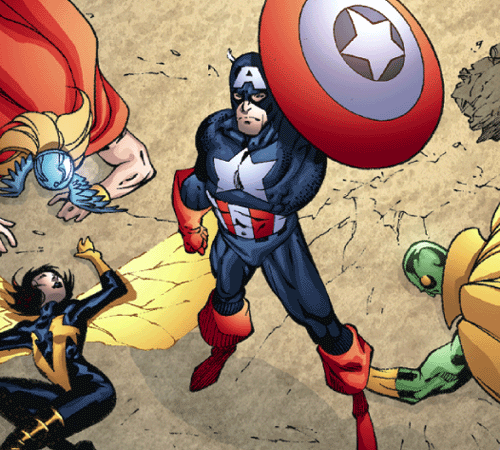
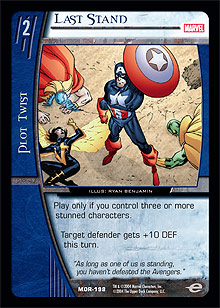 This standard changed with the release of Web of Spider-Man. The core mechanic of the Spider-Friends team, evasion, provided a good deal of potential for a curve deck to retain multiple characters by proactively stunning them to avoid attacks. Finally, there seemed to be a strategy tailor-made for a card like Last Stand. However, the strategy of most Spider-Friends builds was to build to the late game to play out the team’s MVP, Spider-Man, The Amazing Spider-Man. As a result, the decks rarely played 1-drops and often missed their 2-drops. Assuming that the deck followed the curve after that point, then Last Stand wasn’t even potentially playable until turn 5 or 6. Playing a card that would probably be useful only on one or two turns of any game didn’t seem like an effective deckbuilding decision. As such, it continued to go largely unplayed.
This standard changed with the release of Web of Spider-Man. The core mechanic of the Spider-Friends team, evasion, provided a good deal of potential for a curve deck to retain multiple characters by proactively stunning them to avoid attacks. Finally, there seemed to be a strategy tailor-made for a card like Last Stand. However, the strategy of most Spider-Friends builds was to build to the late game to play out the team’s MVP, Spider-Man, The Amazing Spider-Man. As a result, the decks rarely played 1-drops and often missed their 2-drops. Assuming that the deck followed the curve after that point, then Last Stand wasn’t even potentially playable until turn 5 or 6. Playing a card that would probably be useful only on one or two turns of any game didn’t seem like an effective deckbuilding decision. As such, it continued to go largely unplayed.
We might never have seen a potent deck highlight Last Stand if it weren’t for the X-Men set. As part of the new set, we revisited the evasion mechanic with the Morlocks team. The Morlocks take evasion to a whole new level. Not only do the Morlocks have an abundance of great low-drops with evasion, but most of these characters also have strong effects that key off of becoming stunned. This sounds like the perfect framework to utilize our featured card! We’re going to build the ultimate Last Stand deck with the sewer-dwelling mutants—a deck that will no doubt cause fits for all of our opponents in those cutthroat games!
The Build
I suppose that it goes without saying that we’re going to put in four copies of Last Stand, but I’ll say it anyway. In addition, we’re going to include four copies of the Morlock variant on Last Stand, Shrapnel Blast. Shrapnel Blast isn’t as defensively strong as Last Stand, but it makes up for that by being an effective pump while attacking or defending, and it would be foolish of us to ignore that kind of versatility. At the end of our list of offensive/defensive pumps is Retribution. While this card doesn’t do anything for our characters’ DEF, it is useful while either attacking or defending. I think it would be a mistake for us to ignore any card that can easily play the dual role of Nasty Surprise and Savage Beatdown.
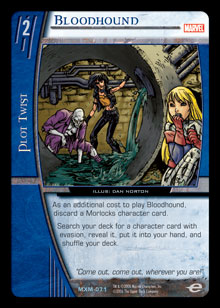 Continuing with our plot twist selections, we need to consider possible character searchers. Since our deck is going to be chock full of Morlocks characters with evasion, then four copies of Bloodhound is a no-brainer. If there were ever a search card that was meant to be in this deck, this is the one. The only shame is that we are limited to four copies. Why? Because experience has shown that missing a drop in a cutthroat game can be disastrous. Since this is the case, we need to include a couple more search cards. A great choice in this case would be Secret Origins. Since we will only have the initiative once or twice in any cutthroat game, there will usually be one opponent each turn who matches the cost of the drop we want on that turn. It may not be as potent in one-on-one play, but Secret Origins is a solid search card nonetheless.
Continuing with our plot twist selections, we need to consider possible character searchers. Since our deck is going to be chock full of Morlocks characters with evasion, then four copies of Bloodhound is a no-brainer. If there were ever a search card that was meant to be in this deck, this is the one. The only shame is that we are limited to four copies. Why? Because experience has shown that missing a drop in a cutthroat game can be disastrous. Since this is the case, we need to include a couple more search cards. A great choice in this case would be Secret Origins. Since we will only have the initiative once or twice in any cutthroat game, there will usually be one opponent each turn who matches the cost of the drop we want on that turn. It may not be as potent in one-on-one play, but Secret Origins is a solid search card nonetheless.
Our final plot twist explores a couple of beneficial effects. One problem with powerful attack pumps is that our effects can potentially be blunted by wayward reinforcement effects. Since we might have one or two attacks per game that we would like to push through damage, we’re going to look at another Morlocks variant of a Marvel Origins card. No one will argue that Blind Sided is a devastating answer to reinforcement effects. Well, Morlock Justice is all of that and more. Not only does Morlock Justice remove and prevent further reinforcement (a la Blind Sided), but it also tosses in a neat burn effect to boot. In later turns, Morlock Justice can easily burn an opponent for 5 to 6 endurance. Justice indeed!
We have a few locations that will be welcome in the deck. First and foremost, we should consider one of the major problems with evasion-based decks: KO effects. If we want to maintain our board, we need to make sure that our strategically stunned characters won’t become prematurely removed. Our best bet to maintain our board is The Alley. An activation of The Alley prior to the combat phase will ensure that our stunned characters won’t be KO’d by opponents’ effects during the combat phase (not even by Total Anarchy!). Granted, our characters are still vulnerable outside of the combat phase, but The Alley is still an effective KO-prevention card. Another benefit of The Alley is that its other effect will result in a decent amount of direct endurance loss for our opponents. Much like Morlock Justice, the burn effect of The Alley can be a very useful tool for our deck in later turns.
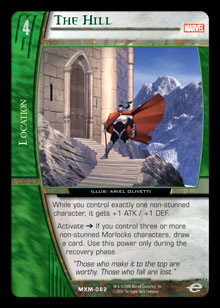 A less critical but still potent location for our deck is The Hill. We should find that our deck’s strategy often results in having one non-stunned character in play. The +1 ATK/+1 DEF bonus that The Hill provides in this scenario is certainly beneficial. Of course, the second effect is probably the more functional of the two. Since the recovery of characters who evaded during a turn occurs during the recovery phase, there is a point after these characters recover when we can activate The Hill to draw a card. Assuming that we can maintain our board, this will almost always result in an extra card every turn from turn 4 onwards, and free cards are rarely bad.
A less critical but still potent location for our deck is The Hill. We should find that our deck’s strategy often results in having one non-stunned character in play. The +1 ATK/+1 DEF bonus that The Hill provides in this scenario is certainly beneficial. Of course, the second effect is probably the more functional of the two. Since the recovery of characters who evaded during a turn occurs during the recovery phase, there is a point after these characters recover when we can activate The Hill to draw a card. Assuming that we can maintain our board, this will almost always result in an extra card every turn from turn 4 onwards, and free cards are rarely bad.
As far as characters go, we have a bunch of really great character choices for our deck. At 1, there are three characters that jump out. Electric Eve and Artie are emblematic of the earlier mention of stun-based effects. Electric Eve makes sure that any time she stuns, an opponent will usually take damage in return. Artie, on the other hand, can effectively remove a point of damage by removing a point of ATK from an opposing character. In either case, our 1-drops are great enablers for our third 1-drop, Tommy. If you recall from my article on Roll Call!, I mentioned that I am a big fan of characters with alternate recruit costs. Tommy fits the bill very nicely with the ability to enter play for free when we have a stunned character on the board, which won’t be difficult in the least with our deck.
Our 2-drops continue the trend of useful stun-based effects. Tar Baby has impressive size for a 2-drop, sporting a 3 ATK/3 DEF frame. With one copy of Shrapnel Blast, Tar Baby should easily stun an opposing 4-drop. Tar Baby’s effect is also nice. Certain abusive recursion cards like Dr. Light, Master of Holograms and Garth, Tempest become absolutely useless when Tar Baby is on the board. Of course, our second 2-drop might be even better. Leech isn’t as big as Tar Baby, but he makes up for that with a built-in Utility Belt effect. Most competitive players would tell you that a card that effectively reads, “Pay 2 endurance and discard a card to negate target character payment effect,” is very valuable.** With the plethora of powerful character payment effects in the Vs. System, Leech becomes an absolutely incredible control card for our deck.
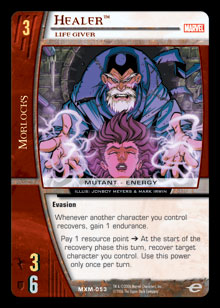 Our character choices onward will seem to be a bit bizarre. We loaded up on our early drops because we’re only going to have four or fewer copies of a single character from 3 onwards. While this may seem crazy, we should have enough search cards to ensure that we hit our characters at each drop. At 3, there can be no other than Healer. His payment effect will rarely come into play for our build, but he’s a sizable defender at 3 with a wonderful endurance-gaining effect. One trick to understand with Healer is that evasion recoveries use the chain just like other effects. So, in order to get as much out of Healer as possible, we will always want to put his recovery from evasion on the chain last. Since the last effect on a chain resolves first, Healer will be our first character to recover. Then, after he’s recovered, his effect will trigger for each of our other characters that recovers, even those characters that were stunned as a result of combat (though Healer’s effect won’t actually trigger until the start of the next turn, since no effects can trigger during the wrap-up).
Our character choices onward will seem to be a bit bizarre. We loaded up on our early drops because we’re only going to have four or fewer copies of a single character from 3 onwards. While this may seem crazy, we should have enough search cards to ensure that we hit our characters at each drop. At 3, there can be no other than Healer. His payment effect will rarely come into play for our build, but he’s a sizable defender at 3 with a wonderful endurance-gaining effect. One trick to understand with Healer is that evasion recoveries use the chain just like other effects. So, in order to get as much out of Healer as possible, we will always want to put his recovery from evasion on the chain last. Since the last effect on a chain resolves first, Healer will be our first character to recover. Then, after he’s recovered, his effect will trigger for each of our other characters that recovers, even those characters that were stunned as a result of combat (though Healer’s effect won’t actually trigger until the start of the next turn, since no effects can trigger during the wrap-up).
Turn 4 is a gut-wrenching choice for us. We would really like to play Hump on this turn. Given his immense size and ability to get bigger, he could be a real problem for our opponents to effectively deal with. However, Hump’s discard requirement can randomly be problematic, as only about half of our other characters will have the Physical trait. In our deck, we’re going to try finesse over size. This means that Storm, Leader of the Morlocks gets the nod. While she is nowhere near as large as Hump, she has a leader effect that will save us a bunch of endurance. Assuming that we hit our 1-, 2-, and 3-drops (a valid assumption), we would normally be losing 6 endurance each turn to evade with these characters. Even though Healer can help us regain some of this endurance, we’ll still be losing out on a substantial amount of endurance in the long run. Storm will defray these losses, making our powerful stun-based effects cost absolutely nothing, and turning Healer’s effect into a source of free endurance gain.
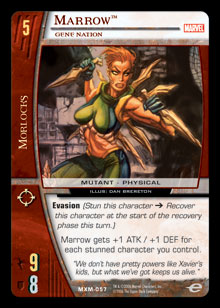 We make up for our loss of a massive character at 4 with our choice at 5. Barring unforeseen board control or a very poor draw for us, Marrow will be a giant for us on 5. We should reasonably have three to five characters in play on turn 5. Depending on how many characters we evade with, Marrow can easily become the size of a small 7-drop. With the support of Last Stand and Shrapnel Blast, there won’t be a 5-drop in the Vs. System who can tangle with her. Take that, Albert Gaines ◊ Nuke!
We make up for our loss of a massive character at 4 with our choice at 5. Barring unforeseen board control or a very poor draw for us, Marrow will be a giant for us on 5. We should reasonably have three to five characters in play on turn 5. Depending on how many characters we evade with, Marrow can easily become the size of a small 7-drop. With the support of Last Stand and Shrapnel Blast, there won’t be a 5-drop in the Vs. System who can tangle with her. Take that, Albert Gaines ◊ Nuke!
Turn 6 is a bit of a letdown after 5, since Marrow is nothing short of amazing, but Callisto is still a solid character. She boasts an above-average 14 ATK, meaning that she can often attack up the curve into 7-drop. Her effect is also useful in the late turns, as she can turn those little characters that are doing little past evading every turn into +1 ATK/+1 DEF counters for our bigger characters (though we’ll usually just want to leave those characters in play to boost Marrow).
Finally, at 7, we have one of my new favorite characters. Ape is decent as a 7-drop in terms of his stats, with 16 ATK/14 DEF. However, his effect is absolutely amazing. Assuming that our opponents can’t stun Ape through combat, since his size and the fact that he has evasion makes stunning him difficult, Ape basically changes the win condition for our opponents, requiring them to stay in positive numbers while dropping us into the negative during wrap-up. Ape combines very well with several of the cards in our deck. For example:
- Use Callisto’s effect to gain a +1 ATK/+1 DEF counter by sending one of our smaller Energy characters back to our hand, then discard the Energy card for Ape’s effect;
- Evade several characters, burn an opponent with Morlock Justice for enough to put that opponent below 0 endurance, then discard for Ape’s effect;
- If we are below 0 against an opponent who’s close to 0, evade with Ape. During the recovery phase, recover as many characters as possible (including Ape) to trigger The Alley, then discard for Ape’s effect prior to wrap-up to win before the endurance totals are checked.
There may be more combos possible, but I think we’ve sufficiently covered the basics.
Finally, we are at the end of deckbuilding. Here’s the glorious cutthroat monster we have summoned:
Spooky’s Last Stand (60 Cards)
Characters (33)
3 Artie, Arthur Maddicks
3 Electric Eve, Live Wire
2 Tommy, Runaway
4 Leech, Inhibitor
4 Tar Baby, Adhesive Ally
4 Healer, Life Giver
4 Storm, Leader of the Morlocks
4 Marrow, Gene Nation
3 Callisto, Morlock Queen
2 Ape, Metamorph
Plot Twists (21)
4 Bloodhound
4 Last Stand
3 Morlock Justice
4 Retribution
2 Secret Origins
4 Shrapnel Blast
Locations (6)
4 The Alley
2 The Hill
Our mulligan is generally going to be for two or three character cards that fill our mid- to late game (i.e., turns 3 through 7). Since we have sixteen characters costing 2 or less, we should hit our early drops a majority of the time even if we are forced to mulligan a few of them. After that, our search cards should help us fill our remaining drops. If, however, we miss one or two of our early to mid-game characters, we can easily drop multiple characters on turn 6 instead of playing Callisto.
While this deck is designed for cutthroat, it can be converted fairly easily to one-on-one. A card that might merit consideration for one-on-one play is Backs Against the Wall. While Last Stand is a mighty defensive weapon, it’s hard to argue with any card that can remove all attackers from an attack altogether. The preferred initiative would probably be odds so as to effectively utilize Marrow and Ape.
We have reached the end of our janky journey for this week. As always, I am happy to hear from you folks out there, so drop me a line at BigSpooky1@hotmail.com. I’ve been receiving some great emails from readers over the past couple of weeks, and I sincerely appreciate everything that you’ve had to say.
Take care, everyone! If you’re not too deep into testing for PC Atlanta, get some friends together to play some cutthroat, and you can give the Morlocks a go. We’ll see you next week with another issue of Breaking Ground!
* To date, the greatest number of copies of Anti-Life Equation that I have managed to have in play at one time in a cutthroat game is three. On those rare occasions, there were stunned characters beyond that of anything you can ever imagine. I had hoped to one day reach four copies in play simultaneously, but everyone has been packing copies of Have a Blast! and War of Attrition lately. Apparently, they don’t find “Anti-Life Insanity” nearly as humorous as I do!
** As I mentioned earlier, Injustice Gang is a very popular deck in our cutthroat games. The beauty of a character like Leech is that a single copy in play forces your opponent to look at other players when considering a target for Scarecrow, Psycho Psychologist. When you’re holding twenty or more cards in hand, Leech veritably becomes your deck’s MVP!